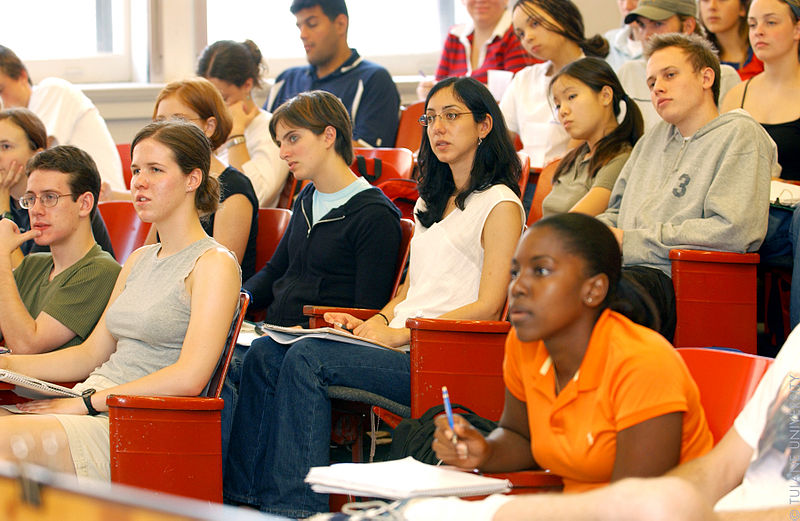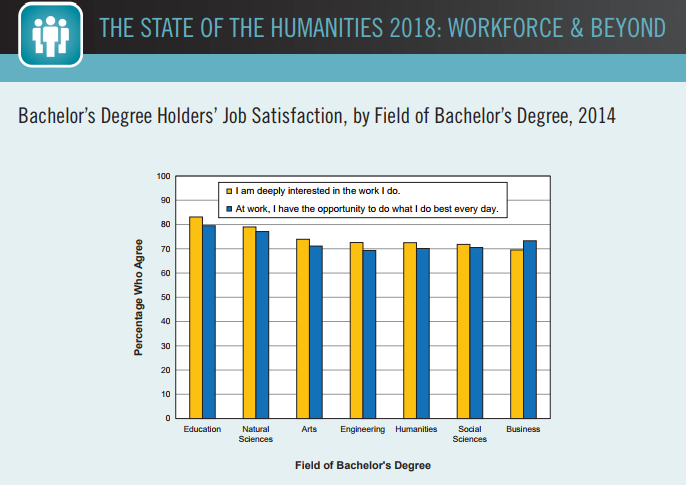CAA News Today
Conference Submissions for CAA 2019
posted by CAA — February 27, 2018
CAA 2019 Annual Conference
February 13-16, 2019
New York, NY
Hilton Midtown
Beginning March 1, 2018, CAA members are invited to submit the following proposals for review to the 2019 CAA Annual Conference Committee: Complete Sessions, Sessions Soliciting Contributors, and Individual Paper/Project proposals. Submissions that cover the breadth of current thought and research in art and art practice, art and architectural history, theory and criticism, studio art, pedagogical issues, museum and curatorial practice, conservation, design, new media, and developments in technology are encouraged.
The submissions portal closed on April 27, 2018.
PROPOSAL SUBMISSION TYPES
Complete Session
The organizer has complete information about the session including names and affiliations of all session participants, presentation titles, abstract texts, etc.
Session Soliciting Contributors
The organizer proposes a session title and abstract that will require a call for participation. The list of accepted Sessions Soliciting Contributors will be posted on the CAA website in late June or early July, 2018. Session organizers select papers and projects based on their own requirements. See CAA 2019 Call for Participation section below for more information.
Individual Paper/Project
An individual CAA member may submit an abstract (with title), which, if accepted, will be included in the 2019 conference as part of a composed session with others accepted in this category based on subject area or compatible content.
OPENS: March 1, 2018
DEADLINE: April 27, 2018 [closed]
Please note: To submit a proposal, individuals must be current CAA members. All session participants, including presenters, chairs, moderators, and discussants, must also be current individual CAA members. Please have your CAA Member ID handy as well as the member IDs of any and all participants as this is a required field on the submission form. Please note that institutional member IDs cannot be used to submit proposals. If you are not a current individual member, please renew your membership or join CAA.
The Annual Conference Committee members review over 800 submissions each year. They take into account subject areas and themes that arise from accepted proposals to present as a broad and diverse a program as possible. The Committee selects between 250-300 sessions for each conference and it must, at times, make difficult decisions on submissions of high merit.
CAA schedules the conference program so that there are back-to-back sessions with similar content. However, given the number of sessions, this is not always possible. All sessions are 90 minutes in length and are scheduled Wednesday, February 13, through Saturday, February 16, in the following timeslots:
- 8:30—10:00 AM
- 10:30 AM—12:00 PM
- 2:00—3:30 PM
- 4:00—5:30 PM
- 6:00—7:30 (Thursday, February 14, and Friday, February 15, only)
CAA AFFILIATED SOCIEITES AND CAA COMMITTEES
CAA Affiliated Societies and CAA Committees may each submit for one guaranteed session in the Complete Session or Session Soliciting Contributors category according to the general session proposal deadlines. Visit Affiliated Society membership for more information on participating in the CAA Annual Conference.
GENERAL PROPOSAL SUBMISSION INFORMATION
- Session and paper/project abstracts should be no more than 250 words in length.
- Please follow the Chicago Manual of Style for your submission.
- The accuracy of information in the submission is important as, if selected, it will be transferred to the conference program, abstracts booklet, website, etc., exactly as written.
KEY DATES
- March 1 – April 27: Call for Proposals (includes Complete Session, Session Soliciting Contributors, Individual Paper/Project)
- Early July: Notifications sent to all submitters
- July: Call for Participation for accepted Sessions Soliciting Contributors posted on CAA website
- End July: Notifications sent to accepted individual paper/project participants regarding composed session configurations
- Late August: Organizers of Sessions Soliciting Contributors finalize session information and notify accepted contributors
- September 4: Deadline for updated accepted session content entered into portal by original submitter for all categories for print and web publications (includes any required edits to abstracts, titles, and speaker order)
- mid-September: CAA 2019 Annual Conference schedule finalized
- October 8: CAA 2019 Annual Conference schedule posted on CAA website; online conference registration opens
- December 16: Early conference registration closes
- December 17: Advance conference registration opens
- February 8: Advance conference registration closes
FORTHCOMING CALLS FOR SUBMISSIONS
Poster Session
OPENS: May 21, 2018
DEADLINE: August 15, 2018
CAA invites proposal submissions for Poster Sessions at the CAA 2019 Annual Conference. Poster Sessions offer excellent opportunities for informal discussion and conversation focused on topics of scholarly or pedagogical research. Proposals require a description of the project (up to 250 words), with a title and member CV.
Exhibitor Session
OPENS: May 23, 2018
DEADLINE: September 14, 2018
Registered exhibitor at the 2019 conference are welcome to propose full sessions or workshops (ninety minutes in length) for inclusion in the full-conference program. These sessions should convey practical information, professional expertise, or historical/scholarly content and may not be used for direct marketing, sales or promotion of products, publications, or services or programs.
Call for Participation for accepted Sessions Soliciting Contributors
The CAA 2019 Call for Participation (CFP) for accepted Sessions Soliciting Contributors will be posted on the CAA Annual Conference website on June 29, 2018. Submissions will be accepted for review through August 6, 2018.
Beginning June 29th, 2018, single paper or project submissions in response to the CFP should be sent directly to the session chair(s)—if there is more than one session chair, send materials to both chairs. Proposals should include a proposal form (found at the end of the CFP), an abstract of your presentation, a cover letter to chair(s), a shortened CV, and work documentation (if necessary).
FREQUENTLY ASKED QUESTIONS
Q: Do I have to be a CAA member to submit a proposal?
A: All conference participants (presenters, chairs, discussants) must be CAA members to participate in the annual conference. A CAA member ID number will be requested for all conference participants in the online submission form. However, if you do not have all CAA ID numbers available for participants, you may enter them when you obtain them. If you are not a member of CAA at the time you submit the proposal, you will not be prevented from submitting. You may work on the submission in stages until the proposal deadline.
Q: Is CAA membership required to participate on a CAA session?
A: Yes, ALL session participants (presenters, chairs, discussants) must be members of CAA in order to participate in vetted conference sessions.
Q: Is CAA membership required to participate on an Affiliated Society guaranteed session?
A: Yes, all session participants (presenters, chairs, discussants) must be members of CAA in order to participate in guaranteed Affiliated Society sessions.
Q: Can someone who is not a CAA member participate in a panel?
A: We require all conference session participants to be CAA individual members.
Q: How long is a session?
A: All CAA 2019 sessions are ninety minutes in length. Please plan either session or paper/project presentations accordingly.
Q: How many people should be on a panel?
A: For a traditional ninety-minute session, we suggest one chair, four participants, and one discussant. This format allows introductions, fifteen-minute presentations, and Q&A. CAA encourages innovative session formats but all session participants must plan accordingly.
Q: How many ways can I participate in conference sessions?
A: To allow a greater number of CAA members to participate in the conference, CAA members can participate in the following roles only once during a conference: chair, presenter, discussant. They can serve in all three roles, but cannot perform any of these roles more than once. For example, they can serve as chair and present in one session, and serve as discussant at another session, but cannot present twice.
Q: Can I attend the session for free if I am presenting on that session?
A: While you cannot attend a session for free, even for the one you are presenting in, we do offer a number of conference registration options including full registration, day passes, and single session time slot tickets.
Q: Can I plan something other than a traditional panel?
A: YES! Feedback from our attendees reveals that they want to take in information and learn in formats other than several people sitting at table in front of a session room. They very much want more interaction with panel participants. We strongly encourage you to think about presenting your content in a manner other than the traditional panel format. While planning your session, you are reminded that we cannot deviate from the ninety-minute time limitation.
Q: Can I have a two-part session?
A: The Annual Conference Committee aims to include as many contributors as possible reflecting the range of scholarship and expertise. In the submission process, please make the request and the committee will evaluate this based on the number of subject areas received as well as the logistical possibilities.
Q: If I am selected to participate as an individual paper/project participant how is my session arranged?
A: Accepted individual paper/projects are organized by the Annual Conference Committee and the CAA staff into what is called Composed Sessions with other individual paper/projects based on subject area or compatible content. Since there is no formal chair for Composed Sessions a mentor is assigned to the group to provide guidance as needed. Sometimes participants identify one in the group to act as chair, sometimes a CAA member outside the group is asked to lead, other groups choose to go without this formal role.
Q: Are there sessions that are free and open to the public?
A: The mid-day time slot (12:30 – 1:30 PM) is free and open to the public. This time slot is reserved for business meetings and special conversations on hot topics for the field. There are other events throughout the conference which are also free. Check the schedule when it is posted in October for details. Please remember to check back often as the schedule is updated as the conference approaches.
For more information about session proposals for the 2019 Annual Conference, please contact Mira Friedlaender, CAA manager of programs, at 212-392-4405 or Tiffany Dugan, CAA director of programs and publications, at 212-392-4410.
Call for CAA Member Feedback: Measuring College Learning in Art History
posted by CAA — February 16, 2018
In 2013 the Social Science Research Council (SSRC) launched the Measuring College Learning (MCL) project as a way to engage faculty in the effort to understand and improve student learning in their discipline through development of better tools for assessment in higher education. CAA recently partnered with the SSRC to create an MCL-Art History panel that would outline learning objectives for introductory art history courses, including identifying essential concepts and competencies that demonstrate foundational knowledge of the discipline. The MCL-AH panel convened in July and December 2017 to produce a draft document.
The MCL-Art History panel will host an open forum at the CAA Annual Conference from 2:00-3:30 PM on Friday, February 23rd in Room 511A of the Los Angeles Convention Center to collect CAA member feedback on its initial draft of core learning goals. The panel plans to share the draft document, solicit input and observations, and respond to questions from the community. CAA members are also invited to review the draft document and share observations before, during, and after the annual conference (until March 31, 2018).
Link to MCL-AH Document: http://highered.ssrc.org/wp-content/uploads/2018.02-MCL-in-Art-History-Report-for-CAA.pdf
CAA Member Feedback to: edick@ssrc.org
Background on the Measuring College Learning Project
In MCL projects faculty and other experts come together to consider what students should learn in their majors and how that learning should be measured. Panels of experts from six disciplines participated in the first iteration: biology, business, communication, economics, history, and sociology. Several national disciplinary associations—including the American History Association, the American Sociology Association, and the National Communication Association—were actively involved in this project. The culmination of this work was the publication of Improving Quality in American Higher Education: Learning Outcomes & Assessments for the 21st Century (Jossey Bass, 2016). More information and resources from this project are available on-line for free download at: http://highered.ssrc.org/projects/measuring-college-learning-project/.
MCL-Art History Panel Members:
Richard Arum, University of California-Irvine, SSRC Senior Academic Advisor
Cole Edick, SSRC Program Assistant
Christine Havice, Kent State University
Richard Lubben, Lane Community College, CAA Education Committee
Elisa Mandell, California State University Fullerton, CAA International Committee
Walter Meyer, Santa Monica College, CAA Professional Practices Committee
Chika Okeke-Agulu, Princeton University, CAA Board of Directors
Stephanie Smith, Youngstown State University
MCL-Art History Co-Chairs:
Virginia Spivey, Independent Scholar and Consultant, CAA Education Committee
Andy Schulz, Penn State University, CAA Board of Directors
Jim Hopfensperger, Western Michigan University, CAA Board of Directors
Maybe the Pay Isn’t Great, But the Satisfaction Is High
posted by CAA — February 13, 2018
The Humanities Indicators project, an Andrew E. Mellon Foundation-funded initiative, just released the most recent numbers on salaries for those entering the the humanities professions. CAA has been an active participant in the initiative for the past few years.
Their survey shows that as of 2015, for arts graduates in the workforce, the median earnings for art history majors in the workforce with just a bachelor’s degree were $45,000, while those who had gone on to earn an advanced degree (which could be in any discipline) had median earning of $65,000. Graduates who majored in the arts had median earnings of $48,000 (with just a bachelor’s degree) and $60,000 (with an advanced degree). In all cases, these were slightly below the average for all fields.
These updates about earnings are tied to a new report on humanities majors in the workforce, which tries to look beyond earnings, and finds that when it comes to job satisfaction and perceived well-being, humanities majors are pretty much the same as graduates from every other field (including art majors).
Among the key findings in the new report:
- Almost 87% of workers with a bachelor’s degree in the humanities reported they were satisfied with their jobs in 2015, comparable to graduates from almost every other field.
- Over three-quarters of humanities graduates saw themselves at or approaching “the best possible life,” which was similar to the shares among engineering and natural science graduates. Education majors had the highest level on this measure.
- The academic fields were quite similar with respect to their graduates’ level of satisfaction with their personal financial situations in 2014. Among graduates from engineering, barely 50% reported “I have enough money,” while among humanities and education graduates, the share was 42%. (Arts majors had the lowest share on this question.)
- More than a million graduates with bachelor’s degrees in the humanities were employed as managers in 2015, and almost 60% of humanities graduates report managing or supervising employees as part of their job (which was equal to the share of all graduates).
- While much of the report points to similarities, there was one notable difference: only 30% of graduates with a bachelors in humanities perceived a close relationship between their job and their degree in 2014, while more than a third saw no relationship. Fine and performing arts majors were similar on this score. This differed substantially from graduates with science and professional degrees.
An Interview with 2018 CAA Distinguished Artist Awardee Pepón Osorio
posted by CAA — February 06, 2018

Pepón Osorio, Badge of Honor, 1995. Photo: Sarah Welles
Drawing on his childhood in Puerto Rico and his adult life as a social worker in the Bronx, artist Pepón Osorio creates meticulous installations incorporating the memories, experiences, and cultural and religious iconography of Latino communities and family dynamics. The 2018 CAA Distinguished Artist Awardee for Lifetime Achievement, Osorio is a professor in the Community Arts Practices Program at the Tyler School of Art at Temple University. He is also the recipient of a 2018 United States Artists Fellowship, among many other awards and fellowships.
CAA media and content manager Joelle Te Paske worked with Pepón in 2016 on reForm, a project responding to school closures in Philadelphia in collaboration with students, teachers, and Temple University. In the project high schoolers, affectionately nicknamed “Bobcats” after their former school mascot, were invited to contribute to an art installation at Tyler School of Art, where they also met with local politicians to advocate for community-based school reform.
Joelle caught up with Pepón in January 2018 to hear his thoughts on being an artist and professor, and to learn about his hopes for the year ahead.
This interview has been edited for length and clarity.
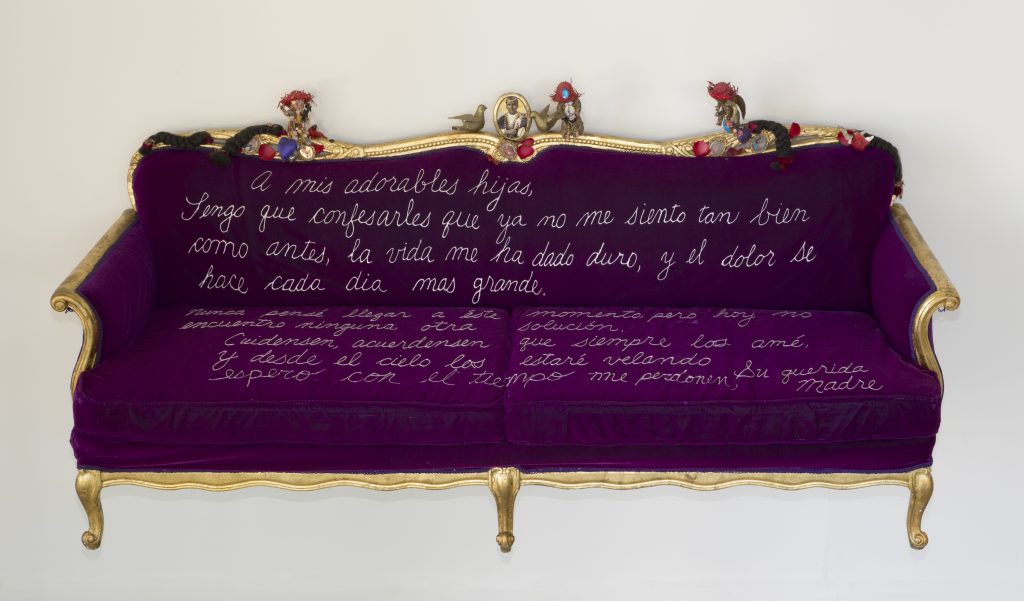
Pepón Osorio, To my darling daughters, 1990. Photo: Carlos Avedaños
JTP: I’m happy to be speaking with you. When I heard that you were getting the award, it was great news!
So, we find ourselves in 2018—how are you doing? What’s on your mind?
PO: I think that I am still processing the fact that we are in 2018 and 2017 didn’t look very good for us. Both as an artist and a citizen. I’m hoping that we begin to tell the truth in a country of lies. I hope that is what 2018 is like. This is a very interesting moment with the CAA lifetime achievement award, because I’ve been mostly thinking in retrospect. How in the world did we get here? How did we get here and how did this happen?
I’m looking in retrospect and trying to see where energy is stored and how to rejuvenate so I can move forward with a new perspective. That’s where I’m at.
JTP: I love that—looking for pockets of energy that are there, but haven’t quite been found.
PO: That in addition to how do we tell the truth in a country of lies? What does that mean? Everything’s been blurry to the point that you begin to doubt. That’s where we are.
JTP: Definitely. And what does your work look like right now?
PO: I am working on a couple of ideas. My production is very, very, very small. I don’t produce tons of work. I only produce work that I feel is urgent and is important. So I’m working on a whole bunch of ideas for possible pieces. Of all those ideas, one will emerge and come out. I’m working with that and also teaching. I’m trying to perfect the transformation of my methodology into a philosophical pedagogy. I’m trying to figure that out without losing touch with my creative self and my sense of curiosity.
JTP: When you say philosophical, do you mean putting together a formal pedagogy? Or more in a spiritual way?
PO: Well, both. I have been teaching at Tyler over the years and I feel that I always want to be able to center myself in my pedagogy in the way that I center myself in my artistic practice.
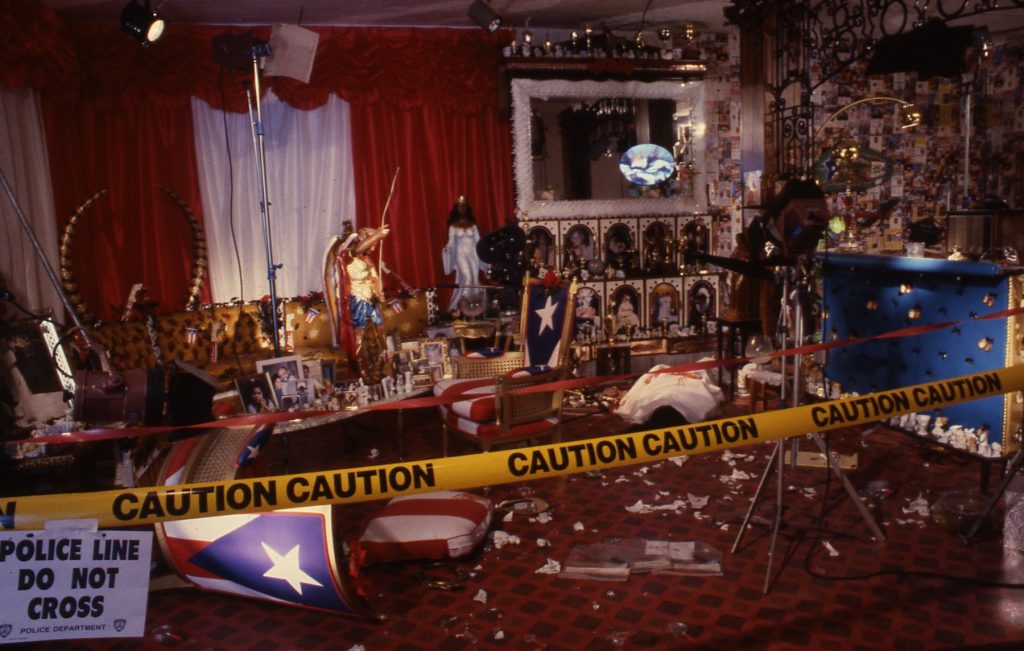
Pepón Osorio, Scene of the Crime… (whose crime?), 1993. Photo: Frank Gimpaya
I’m looking at what I’m really good at and that which I know most, which is my methodology of getting my work done, my practice. How do I transform that into a pedagogy of philosophy? That I can go around and teach something that I feel has this philosophy at the center of the work, similar to my artistic practice. Those are the things that I’ve been doing. A lot of looking in retrospect. Really looking in retrospect at the system.
JTP: That’s great. I’ve enjoyed being at CAA because I’ve been thinking more about history. It’s always there for you to learn from. The more you dig into it, the more you learn about the moment you’re in.
PO: Exactly.
JTP: What are the biggest changes you’ve seen in your time at Tyler as part of the faculty?
PO: The changes that I’m seeing at Tyler are new faculty members are coming in with a preoccupation that seems to be different from the history Tyler was built on. I’m looking at faculty members who are much more interested and preoccupied with things other than the object; where new faculty members are coming in with a clear understanding of what the true intention of becoming an artist is.
So I’m seeing that. I’m seeing transformations. We obviously have a new dean who is also looking at ways of transforming the past into a bright and hopeful future. Which is basically what I think this whole nation should be looking at.
JTP: I’m with you. Feels a little blurry, as you said, right now.
PO: Exactly. I think that the new blood and new faculty members that are coming to Tyler are interested in redefining a lot of concepts. I see that a lot in the world. I see that a lot with new generations of people coming up who are very interested in: “Let’s redefine this thing, because the system as it is simply doesn’t work.”
JTP: Would you say that’s your favorite part of being on the faculty at the moment?
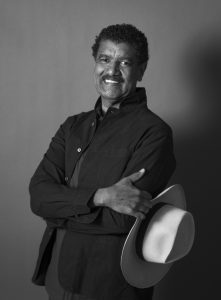
Pepón Osorio
PO: Yes. Also because I always feel that I found a niche in this. As an artist, dealing with the social, the political, the truth, and interdisciplinary work that creates very complex, chaotic environments—all that stuff seems to be so unacademic. I came in and I just felt like, “What in the world? What is my place in all this?” Little by little, by joining a new faculty and redefining, it’s making perfect sense. I’m finding myself more and more comfortable. That there are people around me that are supportive, that understand my trajectory and understand how I got to where I am now, whatever that place is.
It’s wonderful and I think to me that is a highlight. It’s finding a space in academia that feels comfortable and that I can bring the complexity of who I am into it, without necessarily having to be only one person.
JTP: I think that’s beautifully put. Everyone brings their own experiences. No one wants to be part of a monolithic institution that doesn’t let people be themselves …well, ok, some people do. But it’s interesting to me there’s so much more openness for that than I thought there might be, coming to a traditional academic membership organization like CAA, for instance.
PO: Basically, for me, it feels that this is not in demand. I am not filling up a demand of what all the people want to see. This is who I am. In relationship to the earlier question, I just feel like I was able to figure out a way to become myself in a world where people have demands of, “Oh you should be a professor.” Everybody thinks that you should be a [certain type of] professor. No. You just can’t be anybody else but who you are. It just so happened that being a professor is part of that.
We are looking at being an artist from a three-dimensional reality and in a more inter-dimensional way—that being an artist and professor is a very complex human being. I love that. I’d love to embrace that and not hide it from anyone. As a professor, I come in with all my imperfections as well. It’s not like I’m trying to correct them, I’m just going to do a balancing act with all this. That’s me, anyway.
JTP: If there was one thing that you would recommend to students or artists that they should be reading that they aren’t, what would you recommend?
PO: I’m not sure, but a student did ask me the other day if I have a recommendation of what he should be reading and what came out, which is really interesting, was feminist literature. Just listen to that stuff, read it, and understand what it means so then you can place yourself, as a male, in a place of understanding. That’s all.
JTP: I love it—you say, “Yes, I have an answer. Feminist literature.” Done.
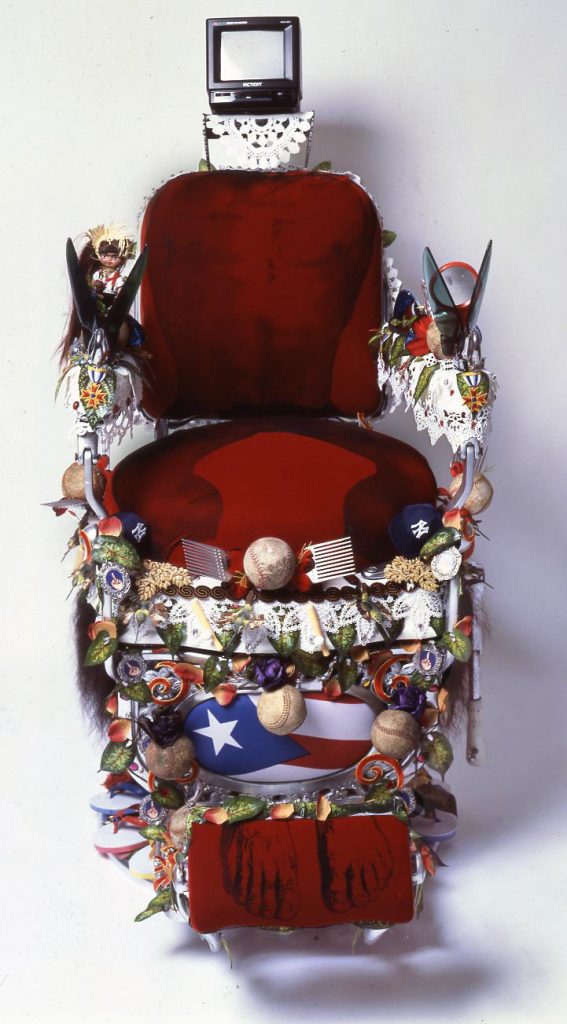
Detail, En la barbería no se llora (No crying allowed in the barbershop),
1994. Photo: Frank Gimpaya
PO: I think that women should be reading it, but I think that men should be getting into it and reading and understanding where it comes from. I think that people, mostly men, will probably begin to empathize with the reality and the system, the fact that it’s not supportive of women.
JTP: I’m curious if you’ve attended CAA conferences in the past? What did you think?
PO: I have participated in the past. I have been in a couple of them.
JTP: It’s my first experience with the conference. It’s enormous.
PO: Yes, it always surprises me how the college system is much bigger than what I always think of it. I just wish that there were much younger people coming in to turn this thing upside down.
JTP: I agree. We’re trying to think of different ways to get closer to that. This year I know that we’re doing outreach to high schools in LA for all the free events. How amazing would it be to have a whole bunch of juniors and seniors in high school from a local public LA high school show up at the LA convention center alongside established, older academics? Just everybody.
PO: So both of them can see each other. Both of them can see each other and it’s like, “Okay, this is what’s coming up,” and the younger will say, “Oh, this is what it’s been.”
Find a happy medium somewhere in there. It’s just too much of the extremes. That’s my reaction. Too much of the extremes.
JTP: I agree. It reminds me of reForm, even just in terms of space—basically allowing people to feel comfortable. I just loved that the Bobcats (high school students who collaborated on the project with Osorio) walked through the main space of Tyler to get down to their classroom. It made Tyler theirs, in a way.
PO: A lot of people asked me, “Why aren’t you doing this piece in their neighborhood?” It was because the chances for the students to come into a college and to occupy space in a college environment were one in a million. I just thought if we can open up a space for them to occupy a classroom, open up a space for them to understand and to begin to look at the social architecture of a university, that’s more than enough for me.
I think that’s basically what I’m referring to when I’m talking about the CAA conference. If we can only suggest and show up a little bit more, that it’s much bigger than that, and that there’s a world out there both ways, that’s it. That’s what needs to happen. So people can come and begin to think differently. That was exactly what happened with the Bobcats. I said, “I’m just doing this at the institution because there are multiple functions in which the institution can work. This is one of them.” We think about institutions as the only place for education. Education is much bigger than that.
JTP: I agree, and I think that gets us closer to the truth you were talking about earlier. It opens up many more opportunities.
PO: Yes. It unties that sense of curiosity in all the kids’ minds.
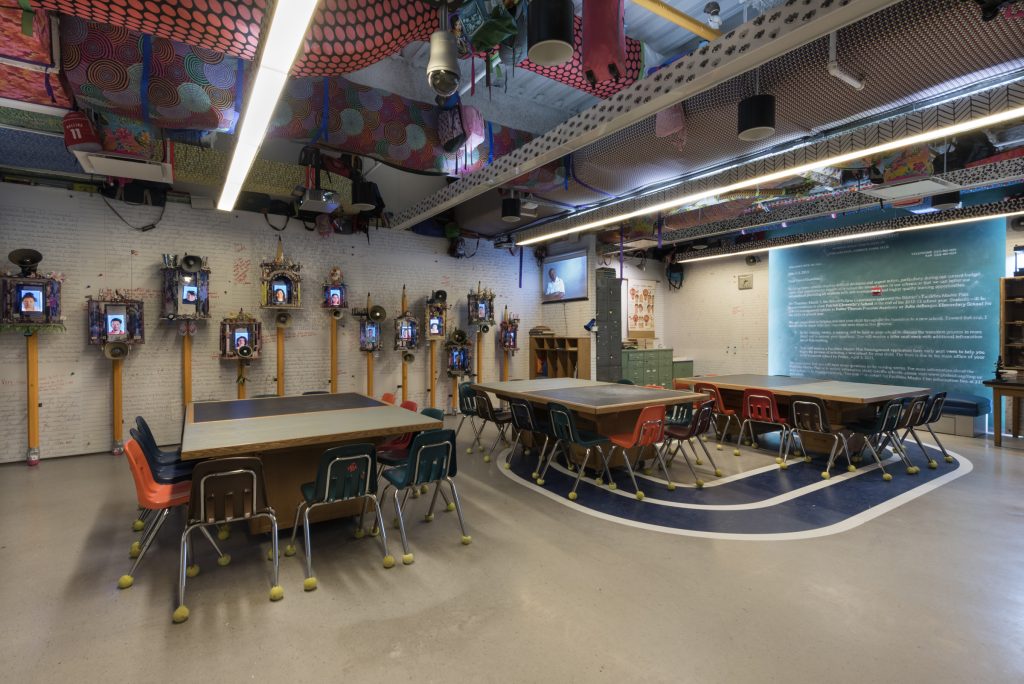
reForm, 2014-2016, installation at Tyler School of Art classroom. Photo: Constance Mensh
JTP: Do you think artists can change the world?
PO: I think artists have changed the world. I think that the changes that I have seen in this country are not by artists alone, but I think that they have. When you’re talking about artists, I think you’re mentioning just these single artists changing the world, and I don’t think that that has happened. But I don’t think that that cannot happen.
I’m saying yes, because in the changes that I’ve seen in the world, there has always been an artist behind that. I do agree, but I don’t think that an artist alone can do it.
To break it down, I think that creativity has always been at the center of world’s change. Artists have always been on the periphery of it. Sometimes at the center of those changes.
JTP: Great, thank you. Lastly, you touched on this a bit, but what gives you hope for the future?
PO: Change.
JTP: Pepón, I’m right there with you. The possibility that it won’t be how it is right now.
PO: Exactly. That’s all. I just hope for change.
CAA’s Annual Conference Convocation, including the presentation of the Awards for Distinction, will occur February 21, 6:00-7:30 PM and will be livestreamed.
Call for Contributions to RAAMP (Resources for Academic Art Museum Professionals)
posted by CAA — December 12, 2017
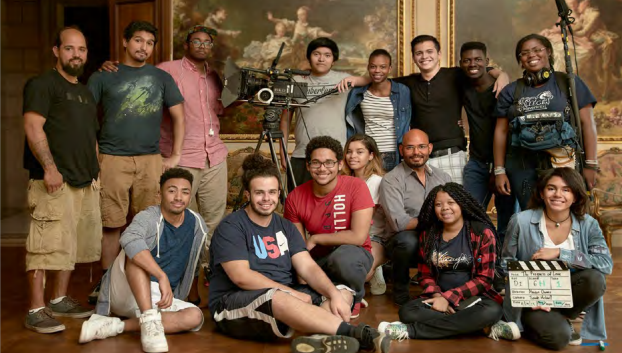
Honor students from The Cinema School at The Frick Collection, 2016, from AAMD’s “Next Practices in Diversity & Inclusion” PDF in RAAMP. Photo: Michael Bodycomb
Given the spirited discussion taking place on a number of curatorial listservs and websites, RAAMP (Resources for Academic Art Museum Professionals) invites submissions to add to its publicly accessible online archive for individuals working in academic art museums.
Examples include museum strategic plans, campaigns for outreach to campus communities, and strategies for diversity and inclusion in the academic art museum, and include PDFs, links, videos, and more.
Click here to submit resources.
You can also browse the existing resources, submit updates, or join the conversation on Humanities Commons.
What is RAAMP?
RAAMP serves to promote scholarship, advocacy, and discussion related to the role of academic art museums and their contribution to the educational mission of their parent institutions. To this end, it functions as a publicly accessible online repository; it collects, stores, and shares resources.
RAAMP is a project of the CAA with support from The Andrew W. Mellon Foundation.
Action Needed! The House’s Bill on Tax Reform Punishes College Students
posted by CAA — November 17, 2017

Yesterday, the House of Representatives passed a tax reform bill, titled the “Tax Cuts and Jobs Act,” that harms the lower and middle class, and puts harsh financial burdens on college students and recent graduates of college. Additionally, the House bill contains a provision that would end the deduction of student loan interest for tax payers. Nearly 12 million people claimed this deduction in 2015.
“This is a very cynical approach to higher education,” said CAA executive director Hunter O’Hanian. “To tax students on money they don’t earn and not allow them to deduct the amount of their student loans will have a chilling effect on higher education in America. These are the future scholars of this country. They are the ones who will preserve our cultural heritage as a nation. It is absurd to imagine that the US House of Representatives seeks to dumb-down future generations in this way. Everyone needs to contact their representatives in the House and Senate and strongly advocate that that this measure never becomes law.”
Under the House version of the bill, graduate students and doctoral candidates would be taxed on the waivers their schools provide them in return for working on campus as part of their professional development in their fields. The New York Times published a piece yesterday by Erin Rousseau, a graduate student at M.I.T., who receives nearly $50,000 in waivers each year. These waivers make school affordable for students, a financial support lifeline to those who otherwise would not be able to pursue graduate educations. The new House tax bill would increase Erin’s taxable income to an imaginary $80,000 a year, pushing her tax burden up by $10,000 a year.
With Congress aiming to pass this bill just as quickly as the House did, it is urgent to speak out now.
Click here to urge Congress to oppose this provision
Read more on the issue:
The House just passed its big tax bill. Here’s what is in it. (The Washington Post)
The House Just Voted to Bankrupt Graduate Students (New York Times)
The Republican Tax Plan Could Financially Devastate Graduate Students (The Verge)
Take Action to Keep Graduate Education Affordable
posted by CAA — November 10, 2017
“The idea of taxing people on money they don’t get is absurd.”
– Hunter O’Hanian, CAA Executive Director, Nov 10, 2017
On November 2, the House of Representatives Ways and Means Committee released the “Tax Cuts and Jobs Act.” Among many provisions that would affect higher education, their version of the bill would treat tuition waivers as taxable income, increasing the tax liability of hundreds of thousands of graduate students.
While the Senate’s version, released on November 9, does not consider tuition waivers taxable income, the House plan could still become law.
This potential additional tax burden would cut into the modest stipends with which many graduate students already struggle to make ends meet. It would make graduate school unaffordable to many, and seriously deplete future generations of scholars and leaders.
With Congress aiming to pass this bill by Thanksgiving, it is urgent to speak out against the House’s provision.
Click here to urge Congress to oppose this provision
Read more on the issue:
Why Graduate Students Are Worried about the Republican Tax Plan (Artsy)
The GOP Tax Plan Will Destroy Graduate Education (Forbes)
The Republican Tax Plan Could Financially Devastate Graduate Students (The Verge)
We thank our colleagues at the National Humanities Alliance for their advocacy on this issue.
Refining Hiring Standards for Part-Time Faculty
posted by CAA — November 02, 2017
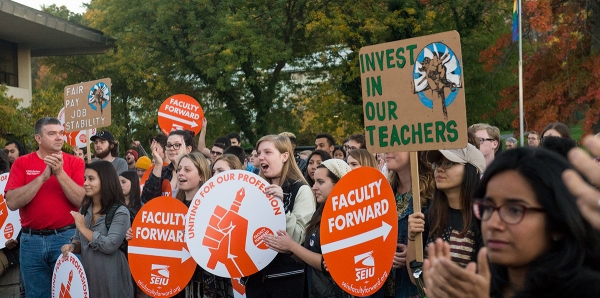
Students and faculty protest at Ithaca College, 2016. Image courtesy Tompkins County Workers’ Center.
CAA is committed to supporting all professionals in the field. This especially pertains to those who are applying for and working as part-time faculty members. For more than twenty years, CAA has been setting standards for hiring part-time faculty.
CAA’s current guidelines are published here and copied below. We want to hear from members about how these might be updated and strengthened.
Hunter O’Hanian
College Art Association
Executive Director and Chief Executive Officer
CAA Guidelines for Part-Time Professional Employment
Part-time employees play a critical role within the art world, specifically in academia, museums, galleries, and other arts institutions. They help meet curricular demands, offer expertise in specialized areas, and/or provide leadership in institutional programming.
Part-time faculty may be referred to with the following terms: adjunct, temporary, lecturer, graduate assistant, and teaching assistant. The terminology and its implications may vary from institution to institution, with the designation “part-time” or “temporary” serving as the most general and therefore consistent names. While this standard is primarily concerned with addressing the conditions of fully credentialed and professionalized part-time or short-term employees who are not simultaneously graduate students, this guideline may be relevant to those employed in conjunction with their graduate studies.
Part-time/temporary faculty and other part-time/temporary employees may be understood to be of several types: Part-time/temporary employees who would prefer full-time positions, part-time/temporary employees with no other employment, part-time employees who teach/work in addition to other full-time employment, and part-time/temporary employees who are retirees. Additionally, some institutions have paid, professional visitors that are not ongoing, full-time employees and also are not recurring, part-time employees. With this in mind, it is acknowledged that there is no singular reason one seeks part-time employment, and while each person may have individual reasons and needs, CAA encourages institutions to chart a path of continual improvements and aspire to provide the best possible working conditions for all part-time/temporary professionals, especially given the increasing reliance on such professionals.
Among key areas of concern are: equitable compensation; employment stability; access to employee benefits, including health care; access to professional development; and safe and adequate working conditions.
Within academia, these areas of concern may be assessed and addressed by comparing part-time faculty roles against full-time tenured/tenure-track faculty roles. Where similar work is performed and similar institutional expectations are held, equitable compensation and resources should exist. Where the treatment of employees in full- and part-time categories is dissimilar, the differences in expectations/compensation and the reasons for those differences should be articulated to both groups.
Institutions that regularly have visiting or guest faculty or curators should define how such roles are similar and different from other full-time and part-time employee roles. If the visiting appointment has responsibilities most similar to a comparable full-time position, the compensation should resemble such a full-time position.
Certain rights and responsibilities should be consistent regardless of one’s employment category. For example, academic freedom should provide the same protections for all. So too should workers’ compensation and other applicable laws that offer employee safeguards.
Working Conditions for Part-Time Employees
Given the great range of mission and expectations in institutions, it is essential that institutions define the roles of part-time employees and provide them with this information as well as information on their workplaces.
- The following written information should be provided by the institution at the time of employment.
- Institutions with a significant number of part-time employees may wish to create and use a part-time employee handbook.
- Statement on the institutional/departmental mission or philosophy
- A full description of the part-time position, including a definition of the role and duties (in the case of faculty, this would include class title, description, size, contact hours, advising responsibilities, and any other responsibilities)
- Description of teaching facilities, office facilities, and support services
- In the case of art and design faculty, description of and access to studio facilities or teaching and for personal, professional development
- Description of financial support and resources available for performing the work and for personal, professional development
- Information on evaluation and promotion procedures
- Information on employment security
- Information on institutional governance and opportunities to participate in it
- Information on any and all institutional expectations
- A written contract for part-time employment should explicitly state the following:
- Compensation including salary, benefits, and any other compensation
- Duties and responsibilities
- Duration of employment
- Process and timing of evaluation
- Availability and timing of contract renewal
- For part-time/temporary faculty:The standards of excellence defined by visual arts programs should be founded upon realistic criteria
- Generally, part-time/temporary faculty do not have research/creative activity duties; if such expectations exist they should be stated in the contract and the faculty member compensated for them
- Part-time/temporary faculty may or may not have service obligations; if service duties are assigned, the faculty member should be compensated for them
- Institutional expectations should take into consideration changes in academia, the commercial
marketplace, and the discipline in question - Whenever possible, faculty should be included in the design of the course taught
- If a course is to be canceled due to under-enrollment or another issue, the faculty member should be notified in a timely manner; if it is canceled at the last minute, the faculty member should be compensated, either in full or on a pro-rated basis for course preparation
- Part-time faculty should have access to private (or shared with the expectation
of privacy when needed) office space for student/teacher meetings - If a part-time faculty member’s institutional contribution is equivalent to that of a full-time faculty member, the part-time faculty member should be equitably compensated in comparison to such a full-time faculty member. If there is no expectation for research or service, differential compensation may be significant. This should be clearly stated in contractual materials.
- For all part-time employees:
- Personal and environmental safety should be a major concern with adequate protection provided by the employer
- OSHA, EPA, and other relevant standards should be followed
- Institutional practices for ensuring safety should be clearly communicated
- Opportunities for advancement in rank, salary, and responsibilities should be given to recurring, part-time employees.
- Adequate administrative support should be provided: mailbox; office space; telephone and computer access; clerical support; library facilities; and teaching/research support such as assistants and/or graders, when warranted
- When additional duties are offered or assigned, and such duties are ones often performed by full-time employees and go beyond the regular scope of part-time employment, the part-time employee should be offered additional and adequate compensation, such as a stipend
The 2013 ad-hoc committee for revision was co-chaired by Thomas Berding, Michigan State University and John Richardson, Wayne State University. The committee included Janet Casey, Skidmore College; Zoe Darling, Milwaukee Institute of Art and Design; Jim Hopfensperger, Western Michigan University; David LaPalombara, Ohio University; Dennis Nawrocki, Wayne State University; and Kate Wagle, University of Oregon.
Lynda.com Membership for $99 (70% off)
posted by CAA — October 10, 2017
 We recently announced new membership levels and new benefits for our CAA members, and we wanted to pull out one new benefit for highlighting because we think it’s really helpful, and kind of a big deal.
We recently announced new membership levels and new benefits for our CAA members, and we wanted to pull out one new benefit for highlighting because we think it’s really helpful, and kind of a big deal.
All CAA members can now get a one-year membership to Lynda.com for $99 (standard price $360). To purchase Lynda.com, log into your CAA account.
Lynda.com is the largest online learning platform, with over 6,000 courses ranging from Teacher Tools to Educational Technology to Content Marketing and Computer Programming.
Lynda.com purchases are nonrefundable and limited to one per CAA member. Please allow up to two business days to receive confirmation email from Lynda.com for access.
Deadlines are Approaching for 2017 CAA Professional-Development Fellowships
posted by CAA — August 30, 2017
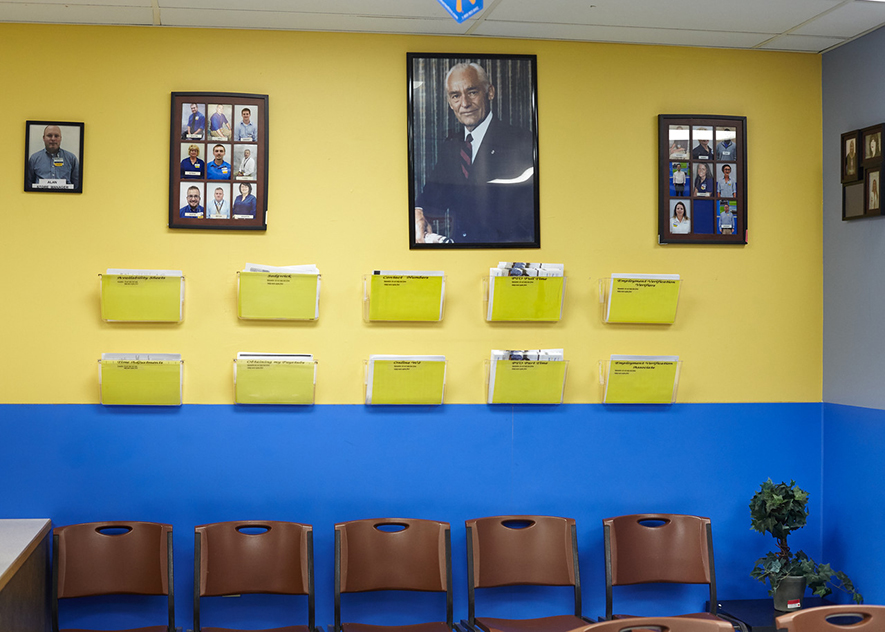
Photography by Daniel Seth Kraus, 2016 Professional-Development Fellowship Awardee
October 2 (PhD candidates) and November 10 (MFA candidates) are the deadlines for the CAA Professional-Development Fellowships. The program supports promising artists, designers, craftspeople, historians, curators, and critics who are enrolled in MFA, PhD, and other terminal-degree programs nationwide.
Fellows are honored with $10,000 grants to support their work, whether it be for job-search expenses or purchasing materials for the studio.
“I remember sitting in my graduate school studio applying for the award. I was day-dreaming about how it could help me be a self-sustaining artist and maybe start my career in teaching. A few months later I received notification of the award and I’m happy to say the grant has helped me enormously with both of my day-dreams, artistic and academic. CAA’s Professional-Development Fellowship for Visual Artists has stabilized a shaky phase of my career and life, continuing an artistic practice after graduate school. The award funds helped me to kick-start my studio space, travel for photography research, and secure teaching positions right out of graduate school. CAA’s support of developing visual artists is certainly outstanding and to an even greater extent, appreciated. I’m happy to now be a CAA member and encourage others to apply for the fellowship without hesitation.” —Daniel Kraus, 2016 Professional-Development Fellowship Recipient
One award will be presented to a practitioner—an artist, designer, and/or craftsperson—and one award will be presented to an art, architecture, and/or design historian, curator, or critic. Fellows also receive a free one-year CAA membership and complimentary registration to the 2018 Annual Conference in Los Angeles, February 21-24. Honorable mentions, given at the discretion of the jury, also earn a free one-year CAA membership and complimentary conference registration.
CAA initiated its fellowship program in 1993 to help student artists and art historians bridge the gap between their graduate studies and professional careers.



